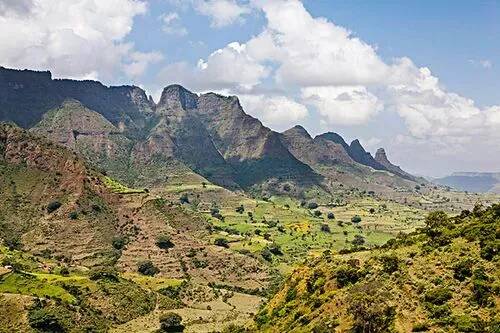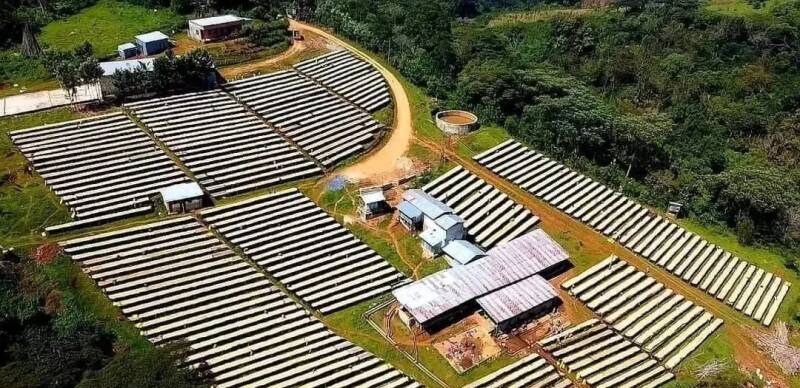Introduction to Yega Xuefei, Ethiopia's coffee producing area
The African continent covers a vast area, with an average elevation of 750 meters, which is known as the "plateau continent". Africa has many mountains, volcanoes, lakes and rivers, due to the ground across the equator, mainly tropical, the annual average temperature is above 20 ℃. The agricultural industry in Africa, which is rich in natural resources, is developed, and many countries are famous for producing coffee, such as Ethiopia, Kenya and Tanzania. Ethiopia is also recognized as the birthplace of coffee. It is also the largest Arabica coffee producer in Africa.

Ethiopian coffee has a very high reputation in the global coffee market, the country has countless native varieties of coffee, coffee can grow in Ethiopia because the country provides an ideal geographical environment and climate for coffee cultivation.
Ethiopia is located in the northeast of Africa, which is dominated by mountain plateaus, most of which belong to the Ethiopian plateau. The central and western regions are the main part of the plateau, accounting for 2% of the country's total. And the East African Rift Valley runs through the whole territory, with an average elevation of nearly 3000 meters in the mountains, while the average elevation in Ethiopia is 2450 meters above sea level.

Affected by high altitude, the country has an annual average temperature of 16 ℃ and a large temperature difference between day and night. The whole year is roughly divided into dry season and rainy season, with an average rainfall of 1237 mm. Ethiopia is an ideal coffee growing area with nearly 50 volcanoes, rich water resources and high-altitude mountain areas.
At present, Ethiopia is divided into 12 states, 2 autonomous administrative regions and 10 coffee producing areas, among which many world-famous coffee producing areas, such as Sidamo, Jima, Haller, Guji and Yirgacheffe, etc., among which Guji and Yegashafi originally belonged to Sidamo, but became an independent coffee producing area because of their unique flavor.
In terms of administrative division, Yega Xuefei is a small town in West Dama (formerly a southern nation state, which was established independently through a referendum in 2019). The area has a rugged and complex terrain, facing Lake Abaya in the west. It has been a wetland since ancient times, with rich water resources, humid climate, abundant rainfall, coffee cultivation at an altitude of 1750-2200 meters, fertile land and plenty of sunlight. It makes the area very suitable for coffee cultivation. Qianjie Coffee has a washed Ethiopian Yega Snow coffee bean, which is selected as an entry representative with jasmine fragrance. Lemon-like acidity, orange, berry and other fruit flavors, fresh and silky taste.
But the Yejashefi coffee producing area includes not only the small town of Yega Sheffield, but also the sub-producing areas such as Vina Wenago, Cochel Kochere and Godibe Gedeb. Venago Wenago is located about 26 kilometers north of the town of Yejashefi, while Cochel Kochere is located in a small production area about 25 kilometers to the south. Godibe Gede is also a township, 60 kilometers away from the town of Yejashafi.
However, because the domestic industry is weak and the economy is mainly agricultural industry, the planting scale of coffee is mostly small farmers such as courtyard coffee (pastoral coffee). Coffee and other crops are grown near the farmers' homes, who take care of them on a daily basis, pick them during the harvest season, and then buy them by middlemen or send them to nearby treatment stations, so most of the coffee here is sold under the names of sub-producing areas or processing plants, such as Yega Ficher beans of Qianjie Coffee and Yega Sheffield Tintin Cooperative coffee beans.
In the earliest days, the Yega Xuefei producing area was mainly treated with a relatively rough sun, spreading the coffee fruit directly on the ground for the sun, probably in the farmer's own yard and on the mud on the balcony, because it was easy to be contaminated by dust in the process. resulting in average final quality.
In 1972, in order to improve the quality of coffee, the Ethiopian government introduced the water washing method commonly used in Central America and set up a washing treatment plant in the Yegashafi region. On the other hand, the flavor of washed Yega Chuefei coffee is very outstanding, with unique flavor such as white flower aroma, lemon acidity and fresh green tea, which is similar but obviously different from Sidamo coffee beans, so Yega Xuefei has become an independent producing area.
At present, the region also pays attention to the production of washed coffee beans, however, with the continuous development of boutique coffee, Yega Xuefei has also begun to try other treatment methods, such as exquisite sun exposure, anaerobic slow sun drying, and so on.
Important Notice :
前街咖啡 FrontStreet Coffee has moved to new addredd:
FrontStreet Coffee Address: 315,Donghua East Road,GuangZhou
Tel:020 38364473
- Prev

Tropical Storm Carlotta makes landfall in Mexico! Heavy rainfall occurred in many places
According to a report by the National Meteorological Administration of Mexico on July 31 local time, after Tropical Storm "Carlotta" formed in the Pacific Ocean made landfall in Mexico, it caused heavy rains and floods in the western part of the country, causing serious economic losses to the region. According to the Meteorological Bureau,"Carlotta Carlotta
- Next

Or open to join? Starbucks, which does not fight price wars, relents!
▲ Click to pay attention| A few days ago, Starbucks announced its third-quarter results report. From a data point of view, in the third quarter of fiscal year 2024 (April 1 to June 30), Starbucks 'consolidated net revenue was US$9.11 billion, a year-on-year decrease of 1%; net profit attributable to parent during the same period
Related
- What ratio of water temperature and ground does the smart cup method use to press coffee? The difference between brewed coffee and filtered coffee?
- What is the standard process for the purpose of coffee cup testing? What is the difference between hand-brewed coffee and cup testing?
- How to use hand-brewed coffee paragon small golden balls? How does cold coffee lock in the aroma of coffee?
- Is American coffee black? What is the difference between American coffee and drip coffee?
- Unexpected! Well-known tea beverage brand Lele Tea will withdraw from the Zhengzhou market!
- Starbucks enters the fashion and beauty industry?! Netizen: Give me an ice American eye cream
- Why can American refills for free? The difference between Americano and American drip pot coffee
- Being chased out of the rain in front of Starbucks?! Store: Sheltering from rain under umbrellas poses a safety hazard
- The white moonlight has changed?! Lucky launches "Big Winter Pear American"
- Hand-brewed coffee three-stage method, high-sweet and universal brewing method to share! What does the high sweet water level of hand-brewed coffee mean?

